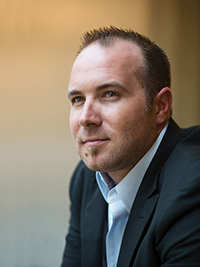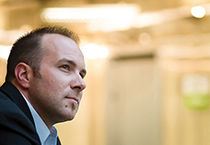Florida-based start-up Ubicquia aims to gives operators an industrial strength platform for the Internet of Things. Nick Booth talks to its chief technology officer, Tre Zimmerman who has a mission to create an Industrial Internet of Things (IIoT) that’s easy to design, set up and manage without breaking the bank. The plan is to integrate software and hardware so that it can work big data over any cloud platform, whether it belongs to a telco, a customer or third party.
To this end Ubicquia has invented a new way to fine-tune the movement of information while locking it in. To the end user it seems simple, but under the bonnet there is a sophisticated chain of checks and counter checks that will confound even the most devious ‘man in the middle’ intruder.
Ubicquia’s strategy, both in its Kairo products and its sales channels, is to devolve power and intelligence to all the millions of places where decisions need to be made. We asked Zimmerman to explain how the company has created a secure single gateway that connects to the cloud, and indeed, how it intends to bring this to market.
IoT Now: You started by making micro-controllers and sensors. Did you suddenly have a ‘eureka’ moment, when you realised that smart cities desperately need a miniature router, storage and comms device (the Kairo) that could get out into more places?
Tre Zimmerman: Our first thought was easy: connectivity is pervasive in the city. Our second thought was more challenging: distributed power is less accessible than you might think. In the end we were driven by our goal, which we achieved, to capture data pervasively and persistently.
IoT Now: Both your product and channel policy seem to be about devolving power out to agents (both human and automated) that can act on it.

TZ: Kairo does exactly that. It was built to live and promulgate at the very edge of the Internet. This is why 802.11 is ideal for many smart city applications. It is an unlicensed, wireless protocol that supports low cost devices around the neighbourhood it is perfect for revolutionising the light pole outside your window.
IoT Now: So is Kairo about keeping on top of all the vast amounts of data, so that the important issues are spotted immediately and acted upon? Should we think of the data as somTre Zimmermane vast, unmanageable herd and the Kairo devices as tiny shepherds, controlling the herd?
TZ: Yes. Putting all those intelligent devices out there is expensive so Ubicquia developed a more affordable way to do it.
Over several months we designed and built a wide range of microcontroller boards with various sensors and actuators. The dimensions of the photoelectric nacelle located on top of a cobrahead street light is governed by a strict standard. Basically, we reenacted the scene from Apollo 13 when the engineers had to create an unorthodox solution to rising CO2 levels. Our team had to stuff all of our creative designs and sensors into a form factor smaller than a soda can.
IoT Now: You only have ten employees. Presumably that means you have plans for a channel of partners?
TZ: Yes, we are following a channel partner strategy. To start, we are working with Ericsson and Avnet. With more than 120,000 combined employees globally we get good leverage, about 12,000 to 1. And we’ll continue to grow our team.
We also want to work with other partners to develop their own IIoT solutions. Because Kairo interoperates with all of the channels, as well as with most of our competitors, our platform can be used by nearly everyone. We can provide whatever is needed, whether it’s the hardware, the software or the cloud technology that the OEMs require.

IoT Now: You are offering the hardware at ‘giveaway prices’ in favour of a subscription-based model. Is that risky? Or is this a better long term model than selling hardware then withdrawing?
TZ: So far, Kairo’s evolution has been closest to the iPhone. We focused on creating a platform that could support a wide range of IoT applications in all sorts of environments and with all sorts of technologies. We made it low cost, positioned lower than the iPhone, tightly integrated, hugely scalable and secure. All like the iPhone.
Instead of creating a point solution like thermostats or nanny cams, we focused on a platform to capture data pervasively and persistently and to deliver it to the cloud of choice in the industrial portion of the Internet of Things. A stable platform that can support thousands of IIoT applications, we think, lends itself to a recurring revenue model. We’ll see.
IoT Now: Can you explain, in simple terms how the Enviira operating system can ingest data and visualise it on the ORCA stack?
TZ: We think of Enviira as a Universal Data API for nearly all data collection devices.
Once the data arrives in the Cloud, whether it’s ours, the customer’s or their preferred vendor’s, the data is organised, presented visually and routed to various users wherever they are and in the formats they prefer.
Given these rich data sets, some of the new, leading edge virtual reality technologies are visually stunning. Again, it’s the captured data that makes all of this possible.
IoT Now: Each Kairo is a self-contained unit. Can these units be easily aggregated in order to create a massive network?
TZ: Kairo devices automatically connect and interconnect with each other securely. For example, Kairo units deployed over several city blocks can LAN into a single Kairo unit that aggregates the data and then launches it over a single WAN connection.
Installing a Kairo device on an existing cobrahead takes about 15 minutes. Twist and remove the legacy photoelectric cell unit. Insert the Kairo unit in its place and twist to secure. This engages the power supply. Then the device calls home to its cloud, authenticates, receives its instructions and data starts to flow. Scaling is easy.
IoT Now: Talking of scalability and teaming up, how easy is it to make your systems work with others? How do you ensure interoperability?
TZ: We follow all data exchange protocols and use standard, commodity hardware. The result is JSON data arriving in an ELK stack anywhere. In addition to cellular networks, Kairo supports Wi-Fi, LPWAN (Sigfox and LoRa), satellite and Ethernet.
We accommodate nearly all standards because we are inspired by the unity, efficiency and affordability they bring. They are just one more manifestation of Moore’s Law that we embrace.
IoT Now: Your plans for eSIM sound quite liberating, since they seem to allow users of cellular networks to get a better deal by being more adaptable. How did you develop this?
TZ: We are simply leaning into the eSIM opportunity along with others. The architecture of our Enviira operating system allows us to take advantage of new advances in the IoT space quickly.

IoT Now: One of your applications involves gunshot detection. Do you need special sensors that recognize the unique sound footprint of a gunshot?
TZ: A generic HD acoustic sensor captures the data from several Kairo devices. The software triangulates and analyzes the acoustic data to locate the event and determine the signature of the type of firearm – often down to the make and model.
IoT Now: Before we have an IIoT surely we need an industrial strength Internet and wide area coverage? Does today’s wireless broadband fall short?
TZ: Yes, it does. There is not enough capacity to accommodate 20 billion devices. The arrival of 5G may help, but IIoT demand is staggering. This is why we have focused so intently on the LAN side of the equation.
At a minimum we need low cost connectivity and low cost devices to collect data pervasively and persistently. IIoT Data Off-load addresses the problems. We knew we wanted low cost interconnected devices using a low cost ISN chipset run by Enviira, our small, tightly integrated operating system.
IoT Now: How will you galvanize all the moving parts of the IIoT into one cohesive body?
TZ: Our customers and the users don’t experience the moving parts. Kairo is a seamlessly integrated, scalable and robust platform that includes all of the components. It’s fully integrated and not a pieces and parts approach.
IoT Now: By 2050, we will have at least 70% of the population concentrated in cities. That could lead to very intense, almost apocalyptic competition for resources. How is Ubiquia going to save us?
TZ: This is where Ubicquia excels. Any IIoT system must resolve two significant constraints: the costs of both acquiring the devices and of their integration and management. The cost of ownership is directly related to the ease of management.
Most IIoT solution providers do not provide all of the devices and components required to provide a comprehensive, fully integrated solution. They rely upon OEM hardware or development kits from thi.rd parties creating a pieces and parts approach. Significant programming and development is required on the part of the operator or the customer. This makes these solutions expensive to deploy at scale. Ubicquia provides all of the required devices, which are purpose developed, integrated and built for our platform at a cost that is, at scale, 60% lower than other solutions.
Ubicquia provides Actionable Big Data in real time so people can respond intelligently. Kairo handles digital image sensors (cameras) of all types: HD stills suitable for facial recognition, HD streaming video at 24 FPS, PTZ and more.
If the Four Horsemen of the Apocalypse do arrive their images will be captured!
The author is Nick Booth, freelance IT & Communications writer










